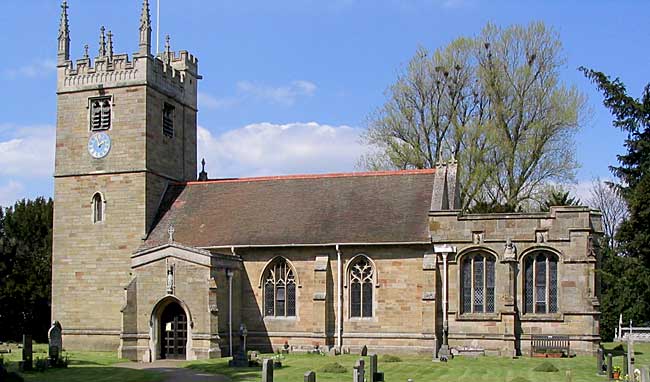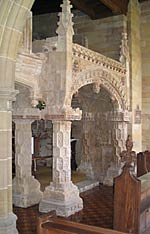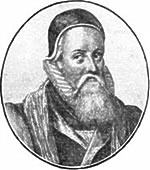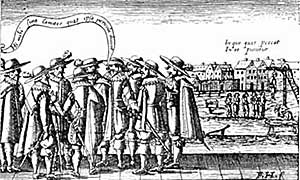
Kingston-on-Soar church.
The Church. Ratcliffe was, as before stated, the mother Church and both Kingston, and Thrumpton, were Chapelries to Ratcliffe. This is what is meant by Thoroton who says that Kingston was commonly esteemed a member of Ratcliffe. That church was given to the Priory of Norton in Lancashire, and so the tithes of Kingston had to follow the gift of the church, and that gift was confirmed by Roger de Laci, constable of Chester, who died in the year 1211 (Godfrey) and who in his deed gift mentions the church at "Radeclive upon Sore, "and the fourth part of the mill there, and the tithes of the other parts. The connection with that Priory continued nearly 200 years, when, in 1409-10 it was transferred to the Priory of Burscough, in Lancashire, and in 1536 the Church of "Ratclyf on Soar, with the Chapels of Kynston, and Thrompton," were valued at the clear yearly sum of £6 13s. 4d.
There must have been a Chapel of ease here somewhat early, for the Pope Alexander III, in 1171 issued a bull, whereby the clergy and laity in every parish in the county went at Whitsuntide to Southwell to join in the solemn procession. The laity would probably be represented by the Churchwarden, who took as Pentecostal offerings for Kingston, 8d. (equal to 16/8 now). Ratcliffe took 8d., Thrumpton 10d., Sutton Bonington 1/1, Gotham 1/1, etc., these places apparently having a larger rateable value. We do not, however, know when the money began to be taken.
St. Wilfrid. St. Wilfrid, to whom the church, when built, was dedicated, was born A.D. 634, and died on Saturday, October 12th, 709, aged 75. He was Bishop of York, the province being then ill denned. He was a man of great energy and perseverance, a considerable builder at York, Hexham, Ripon, etc. He was, at the Synod of Whitby, held in 664, the leader and chief spokesman for the Roman party, as distinguished from the Lindisfarne, or National party, and he pleaded so earnestly, that King Oswin, who presided, decided for the Roman side, on the ground that, as St. Peter had the keys of heaven, "I had rather" said the King "obey the porter of heaven, lest when I reach its gates he who has the keys in his keeping turn his back on me, and there be none to open." Wilfrid made several journeys and appeals to Rome, and wanted to die there, but succumbed on the way. There are ten churches in Notts, dedicated to him, and 40 in the north of England.
Kingston old chapel appears to have been converted into a church, as was Kingston into a parish, under the Babingtons, in the 16th century. Before that period the Babingtons were buried either at the then parish of Ratcliffe on Soar, or in the church of their principal seat of Dethick, in Ashover, or at their still older seat of East Bridgford (Godfrey, 205).

The Babington Monument.
Babington Monument. The Babington Monument in Kingston church was erected in 1538, by Sir Anthony Babington*, and apparently intended for chantry purposes of masses for the dead, as well as to mark the burial vault of the family. It is described by the author of the "Beauties of England," in 1812, as "A canopy formed on a semi-circular arch supported by grotesque pillars, and adorned with upwards of 200 heads of a babe in a tun, the common monumental pun on the family name, and which the architect has thought sufficient to designate the owner, without any description." He complains bitterly of the vandal church-wardens, who had daubed it so completely with yellow ochre, as to have filled up most of the ramifications in the highly embossed foliage of vine leaves, which once adorned it in rich alto relief. Throsby, 22 years before, had said "this part of the church and chancel indicates old age, and has now become a dwelling for birds. They sit near the altar, and sing, and scatter their dung so plentifully, that I could scarcely find a place on the communion table to lay my book. The floor in some places is intolerable."
That monument has been carefully, and thoroughly cleaned and restored, at the expense of Lord Belper, and it is now seen that it was intended to be a sermon in stone, for the carving on it represents the Last Judgment, with the wicked disappearing into the mouth of a monster, and the righteous mounting to heaven through the straight gate. The Almighty is seen in the centre.
The Alabaster, of which the monument is an example, is not only characteristic of the gypsum material in Kingston, selected and polished, but is an example of many beautiful alabaster effigies for which Notts, is famous. There are fine specimens in the churches of Ratcliffe, Holme Pierrepont, Strelley, Willoughby on the Wolds and elsewhere. Persons who desire to follow up the subject may consult the book of of Mr. Geo. Fellows, entitled "Arms, Armour and Alabaster round Nottingham.'' We are told that the earliest alabaster effigy dates from about 1290. Quite a trade was carried on in the days gone by, in figures and images for church purposes, and Nottingham had a great reputation for producing skilful "Kervers" in alabaster, and much of the material was sent all over England, and indeed to Prance. In 1371 a Nottingham man was employed to erect an altar of alabaster in the Chapel of St. George, Windsor. Large columns were formerly taken from the Red Hill quarry, but now, possibly, the blasting operations have shaken the strata. Some very fine specimens have, however, been selected, and used in the entrance Hall, of Kingston Hall.
In "Notes of the Churches of Rushcliffe," by John T. Godfrey, 1887, the frontispiece is an excellent representation of the Babington Monument, and 14 pages of the book are devoted to the Chapelry of Kingston. To that account reference should be made by persons interested.
The Babingtons. Of the Babington family many members have occupied prominent positions in church and state, and in the three local counties especially. There must be mentioned :
1. Sir William Babington, who was Attorney General, Chief Baron of the Exchequer, Chief Justice of the Common Pleas, and whose father was Sir John Babington, of East Bridgford. He retired from the Bench in 1436. In 1455 he was summoned to the Privy Council. He lived to the ripe age of 99, died in 1455, and was buried at Lenton Priory. ("Worthies" 63).
The Babingtons are said to have derived their name from a place called Babington, in Northumberland, where they had resided from the time of the Conquest.
Sir Wm. Babington married Margery, daughter and heir of Sir Peter Martel, of Chilwell, acquiring thereby considerable property in Chihvell, Ruddington and elsewhere. (C. Brown 62).
He founded a chantry at St. Peter's Church,Thurgarton and his son founded one in Flawforth Church.
2. The Rev. Gervase Babington, of the Kingston family, became a Fellow at Trinity College, Cambridge, where to M.A. of Oxford, the degree of D.D. was received. He became Prebendary of Hereford, then Bishop of Llandaff, afterwards Bishop of Exeter, and three years later Bishop of Worcester. He died in 1610, having contributed liberally to the Library of Worcester Cathedral. His writings are said to contain many puns and quaint expressions. They were published in folio, and quarto, in 1615, and again in 1637. ("Worthies," 162).

Anthony Babington, born in 1561, had considerable lands at Kingston, Gotham, Marnham, Normanton, Osberton, Mattersey, and elsewhere, the family residences being at Dethick and Kingston. He was handsome, rich, and a zealous Roman Catholic, who regarded Queen Elizabeth as an usurper. Left an orphan at ten, he was a ward and a page in the family of George, Earl of Shrewsbury, Custodian of Mary, Queen of Scots, and so became acquainted with her. In 1586 he wrote to her that he, "with ten gentlemen, and a hundred of our company and suite will undertake the deliverance of your Royal person from the hands of your enemies for the love they bear to the Catholic cause, and to your Majesty's service," etc. The correspondence was intercepted and he was apprehended. He, on September 19th, 1586 wrote a piteous appeal to Queen Elizabeth, a copy of which may be seen in Brown's "Worthies" page 120, but it was of no avail, and after a trial, he and six others were beheaded, drawn and quartered, and his conspiracy, in which Queen Mary concurred, led to her death as well. He was only 25 when he died.

Babington with his Complices in St. Giles Fields.
The above is copied from ' A Thankfull Remembrance of God's Mercie," by Geo. Carleton, Doctor of Divinitie, and late Bishop of Chichester, 1630. The motto tells that who sins will, in that respect, be punished.
There is in Cheapside, Nottingham, a two gabled building with projecting stories, now occupied by Mr. Harrison, which is said to have been the town house of the Babingtons before the days when they were accustomed to have a house in London. The evidence at Derby is however, much more pronounced, for in that town, in Babington Lane, is Babington House, "and the hall has the wainscote round it full of the same Baboons-upon-Tons carved upon it."
In the Hall of Bothley Temple, Leicestershire, there is—the Rev. F. Brodhurst informs me—a carved cast of the arms of the Babingtons, with a "Babe in a tun," the rebus of the family. Thomas Babington Macaulay, the historian, was born there. In the Rev. Dr. Cox's "Churches of Derbyshire'' —Ashover and Dethic—further information may be obtained, and there is a brass of a Babington, at Hickling, Notts.
The Derbyshire seat of the Babington's at Dethic, may be approached from Cromford Station, by Lea. It was near to Wingfield Manor, one of the places where Queen Mary was confined. The family had at Kingston, what Dr. Thoroton calls "a very fair house," but it gradually fell into decay, for through the treason of Francis Babington, and the unthriftiness of his brother Francis, the property came to Gilbert, Earl of Shrewsbury, and by his daughter, the Countess of Kent, was sold to Lady Hide. In 1790 the large manor house is described as a thing of the past, but there remained a fence wall of considerable substance, and extensive, the gateway of stone also remained. In 1812 we read of this ruin of the old house ''nothing remains but the outward wall of the court and gardens, with an ancient stone gateway, all in a state of delapidation, and speaking the melancholy tale of other times." (Beauties, etc. page 194). There is in the Park, south of the Church, and south-west of the brook, an area of about ten acres, around which, on three sides, there are traces of an ancient moat, which in case of emergency could be filled with water. About 150 yards east of the Station road, is the traditional site of the old hall, and foundations of buildings have been found, and traces of a roadway, a pond, etc. are visible.
* The Babington Monument is now thought to have been erected by Thomas Babington in the 1540s [Simon Roffey, The medieval chantry chapel: an archaeology, The Boydell Press, Woodbridge (2007), p 172]
